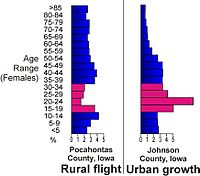
Photo from wikipedia
Abstract Animals exhibit variation in their space and time use across an urban–rural gradient. As the top‐down influences of apex predators wane due to human‐driven declines, landscape‐level anthropogenic pressures are… Click to show full abstract
Abstract Animals exhibit variation in their space and time use across an urban–rural gradient. As the top‐down influences of apex predators wane due to human‐driven declines, landscape‐level anthropogenic pressures are rising. Human impacts can be analogous to apex predators in that humans can drive increased mortality in both prey species and carnivores, and impact communities through indirect fear effects and food subsidies. Here, we evaluate the time use of a common mesocarnivore across an urban–rural gradient and test whether it is influenced by the intensity of the use of a larger carnivore. Using multiple camera‐trap surveys, we compared the temporal response of a small carnivore, the raccoon (Procyon lotor), to the larger coyote (Canis latrans) in four study areas across Michigan that represented a gradient of pressure from humans. We found that raccoon time use varied by study area and was most unique at the rural extreme. Raccoons consistently did not shift their activity pattern in response to coyotes in the study area with the highest anthropogenic pressures despite the considerable interannual variation, and instead showed stronger responses to coyotes in more rural study areas. Temporal shifts were characterized by raccoons being more diurnal in areas of high coyote activity. We conclude that raccoons may shift time use in the presence of coyotes, dependent on the level of anthropogenic pressure. Our results highlight that the variation in raccoon time use across the entirety of the urban–rural gradient needed to be considered, as anthropogenic pressures may dominate and obscure the dynamics of this interaction.
Journal Title: Ecology and Evolution
Year Published: 2022
Link to full text (if available)
Share on Social Media: Sign Up to like & get
recommendations!